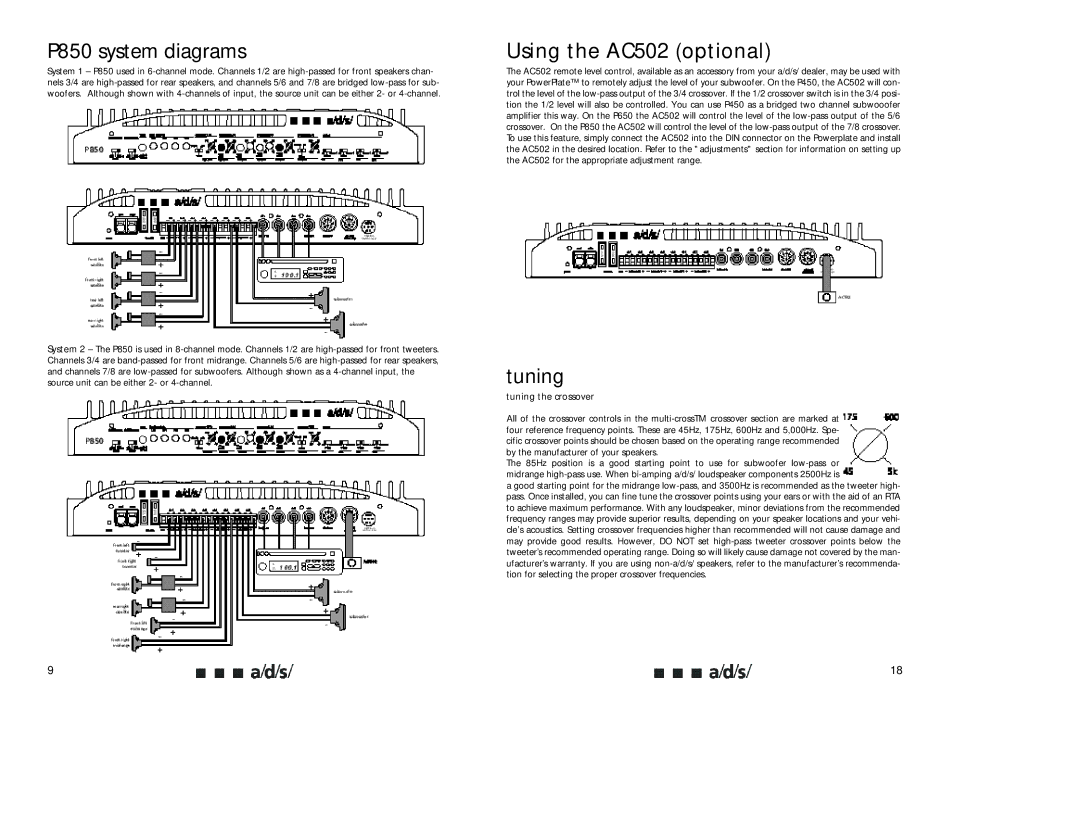P850 system diagrams
System 1 – P850 used in 6-channel mode. Channels 1/2 are high-passed for front speakers chan- nels 3/4 are high-passed for rear speakers, and channels 5/6 and 7/8 are bridged low-pass for sub- woofers. Although shown with 4-channels of input, the source unit can be either 2- or 4-channel.
System 2 – The P850 is used in 8-channel mode. Channels 1/2 are high-passed for front tweeters. Channels 3/4 are band-passed for front midrange. Channels 5/6 are high-passed for rear speakers, and channels 7/8 are low-passed for subwoofers. Although shown as a 4-channel input, the source unit can be either 2- or 4-channel.
Using the AC502 (optional)
The AC502 remote level control, available as an accessory from your a/d/s/ dealer, may be used with your PowerPlate™ to remotely adjust the level of your subwoofer. On the P450, the AC502 will con- trol the level of the low-pass output of the 3/4 crossover. If the 1/2 crossover switch is in the 3/4 posi- tion the 1/2 level will also be controlled. You can use P450 as a bridged two channel subwooofer amplifier this way. On the P650 the AC502 will control the level of the low-pass output of the 5/6 crossover. On the P850 the AC502 will control the level of the low-pass output of the 7/8 crossover. To use this feature, simply connect the AC502 into the DIN connector on the Powerplate and install the AC502 in the desired location. Refer to the "adjustments" section for information on setting up the AC502 for the appropriate adjustment range.
tuning
tuning the crossover
All of the crossover controls in the multi-crossTM crossover section are marked at four reference frequency points. These are 45Hz, 175Hz, 600Hz and 5,000Hz. Spe- cific crossover points should be chosen based on the operating range recommended by the manufacturer of your speakers.
The 85Hz position is a good starting point to use for subwoofer low-pass or midrange high-pass use. When bi-amping a/d/s/ loudspeaker components 2500Hz is
a good starting point for the midrange low-pass, and 3500Hz is recommended as the tweeter high- pass. Once installed, you can fine tune the crossover points using your ears or with the aid of an RTA to achieve maximum performance. With any loudspeaker, minor deviations from the recommended frequency ranges may provide superior results, depending on your speaker locations and your vehi- cle’s acoustics. Setting crossover frequencies higher than recommended will not cause damage and may provide good results. However, DO NOT set high-pass tweeter crossover points below the tweeter’s recommended operating range. Doing so will likely cause damage not covered by the man- ufacturer’s warranty. If you are using non-a/d/s/ speakers, refer to the manufacturer’s recommenda- tion for selecting the proper crossover frequencies.

